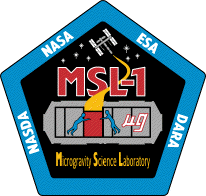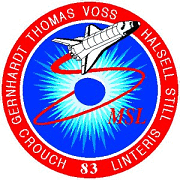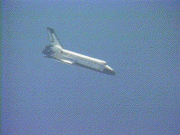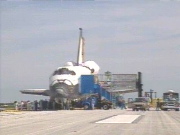






 Mission Notes
Mission Notes
The shuttle STS-83 mission launched on April 4, 1997
was a special mission for the involvement of Scientists and Engineers having current and/or former associations with Princeton. Dr. Greg Linteris, '79 *90, on leave from the National Institute of Standards and Testing, flew the mission as a Payload Specialist for the Microgravity Science Laboratory-1 (MSL-1) package carried aboard the orbitor. Prof. Paul Ronney of University of Southern California (and a former Assistant Professor in Mechanical and Aerospace Engineering at Princeton) was one of the two Alternate Payload Specialists for the flight, and he is also the Principal Investigator of SOFBALL, one of two combustion experiments operated in CM-1 aboard MSL-1. Prof. Forman Williams '55 of the University of California, San Diego (and a former Professor in Mechanical and Aerospace Engineering at Princeton) is the Principal Investigator of both the DCE and FSDC-2 experiments that were aboard MSL-1. Prof. Frederick Dryer *72, is the co-investigator of DCE and is also a co-investigator on FSDC-2. Prof. Anthony Marchese *96 of Rowan College (who recently obtained his Ph.D. in Prof. Dryer's Laboratory at Princeton) continues to serve as a consultant on the efforts at Princeton and was part of the science team at Huntsville during the mission. Prof. Benjamin Shaw *89 of the University of California, Davis is also a co-investigator on FSDC-2. Dr. David Urban '80 of NASA-Lewis serves as the Project Scientist of another combustion experiment,LSP, operated in CM-1 aboard MSL-1. Finally, Profs. William Russel of Chemical Engineering and Paul Chaikin of Physics at Princeton University were investigators of another experiment on fluid physics aboard MSL-1 called PHaSE. Many Princeton Alums and Faculty have participated in prior shuttle missions; Never before have so many been involved in a single mission.MSL-1.
DCE operation was very successful despite the curtailment of the overall mission due to the fuel-cell problems. As with the other combustion experiments carried aloft on MSL-1, this was the first flight of DCE. However, this particular apparatus is, by far, more operationally complex than any other combustion experiments to have been attempted in space to date. Over the years (since 1983) that that the engineering concepts for DCE have been developed and refined, first in conjunction
with TRW, and then at NASA-Lewis, many have been doubtful that the liquid droplet growth and deployment principals first proposed in collaboration among NASA-Lewis personnel, TRW Systems and the PI's would ever work successfully. The dedicated efforts of the engineering team and project scientists at NASA-Lewis, particularly since 1993, have resulted in spectacular DCE performance characteristics, well within the science requirements originally specified by the PI's. In the final analysis, you have produced a droplet growth/deployment methodology which serves well not only in the present investigations, will be at the heart of any future droplet combustion studies in space. The remote operating characteristics of the equipment were shown to be particularly helpful during the mission.
Due to the dedicated efforts of the crew, the science team, the engineering team, and the many support staff at KSC, JSC, MSFC, and Le-Rc, important science was obtained, even from limited number of experiments conducted. We were able to obtain data on the burning of n-heptane droplets in three of the sixteen different helium/oxygen atmospheres that were carried aloft. The studies were all at atmospheric pressure with 25%, 30%, and 35% oxygen in helium. Ten burns were accomplished using initial droplet sizes generally in excess of 3 mm in diameter, although it appears that we were able to obtain data on one occasion for a 2 mm droplet. For the ten successful experiments, we were able to obtain full sets of data for seven of the runs. Roughly 10 of 19 experimental attempts resulted in successful burns, slightly below the expected probability of success. However, modified operations due to mission curtailment negatively affected this probability, and I expect that we will do much better on re-flight. The data obtained include high-speed back-lighted images of the droplet diameter, CCD intensified images of the chemiluminescent OH emission from the droplet flame, and video natural-lighted images of the burns. We were able to observe real-time data on the ground for six of the experiments, and the transmitted video and flame data were of high quality. Back-lighted data is not down-linked, and we must await post-flight processing to determine the quality of these observations. Initial flame diameter analyses performed by Dr. Nayagam quantitatively confirm that for large initial drop diameters and the lower oxygen concentrations, radiation loss from the flame structure is a major controlling parameter. Droplet burning extinction occurred within ten seconds of ignition, and the droplet flame diameter history increased over the entire burning time, eventually nearly constant diameter just prior to extinction. Large extinction diameters were observed. In the case of the higher oxygen concentrations and/or smaller initial droplet diameters at the same oxygen content, the flame diameter initially increased, reached a maximum and then decreased prior to extinction, indicating that both diffusive and radiative losses are likely influencing extinction. While radiative influences on droplet combustion have been speculated and theoretically supported, these are the first experiments that definitively show such effects. Numerical predictions completed thus far at Princeton for the experiments that were conducted show very similar behavior, and we are anxious to quantitatively compare the complete data sets (burning rate/flame diameter histories, extinction diameter) with the computational predictions.In summary, the DCE experiment operated nearly flawlessly during the flight. In addition to successful operation of the facility by Greg Linteris and Janice Voss, the Science/Engineering Team at Huntsville operated the facility remotely for several tests. The engineering support team members at NASA-Lewis also contributed to the smooth operation of the mission. DCE operations were modified on numerous occasions to accommodate the constraints resulting from changes in the mission timeline, without severely degrading the science that was obtained. I am ecstatic that DCE produced important and new science observations, and I look forward to a successful re-flight.
My personal thanks for the continuing confidence of NASA-Lewis administrators in supporting DCE, to the engineering development team responsible for designing, developing and proofing the hardware, to the many Lewis staff who contributed to software and data analyses developments procedures for DCE, and to the large family of engineering support staff present at Marshall and NASA-Lewis that operated DCE so successfully during the mission. Several have served as Project Scientist for DCE since 1983, and I am grateful to all, including the present Project Scientist (Dr. Vedha Nayagam) and Deputy Scientist (Dr. Renato Colantonio). Finally, my personal thanks to Forman Williams for continued collaborations over the history of DCE.
Prof. Fred Dryer, Princeton University April 17, 1997
UPDATE: STS-94, launched on July 1, 1997 is reflying entire DCE and FSDC-2 experimental Test Matrices which were to have been completed on STS-83. Look at the STS-94 Summary Page for further results from these experiments.



Science Support for Space-Based Droplet Experiments
The experiments and modeling conducted in the Laboratory of Prof. Dryer at Princeton provide scientific support for droplet combustion research in conducted at NASA-Lewis Research Center in the 2.2 second and ZGF 5.18 second droptowers, as well as aboard the Space Shuttle. The first type of shuttle experiment is termed the Fiber Supported Droplet Combustion(FSDC) Experiment. This experiment is designed to be operated within the Glove Box Facility. The FSDC experiment was first flown as FSDC-1 aboardUnited States Microgravity Laboratory-2 (USML-2) launched on October 20, 1995 on Space Shuttle Columbia mission STS-73. A second fiber-supported droplet combustion experiment, FSDC-2,was to operate on Microgravity Science Laboratory-1 (MSL-1), launched aboard STS-83 Space Shuttle Columbia mission launched April 4, 1997. However, the mission was curtailed from 16 days to approximately 5 days by malfunction of one of three fuel-cell systems aboard the orbitor. The operation of this experiment was precluded altogether by the shortened mission.
The second type of Shuttle experiment supported by Princeton is called the Droplet Combustion Experiment (DCE). The first flight of this facility experiment was as part of MSL-1 aboard the STS-83 launched April 4, 1997. This experiment successfully operated during the curtailed mission to achieve the first observations of free-floating, isolated droplet combustion in space. A re-flight of this mission is presently scheduled for July 1, 1997.
Future flights of both experimental configurations for studying droplet combustion are currently being planned, and droplet combustion research is also continuing in the NASA-Lewis drop towers.
Return to Microgravity Droplet Combustion Home Page
http://www.princeton.edu/~fldryer/nasa.dir/sts83.htm
Last updated: July 3, 1997